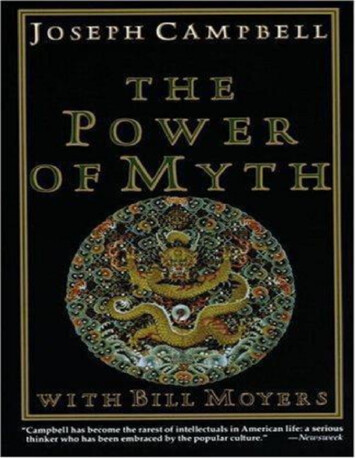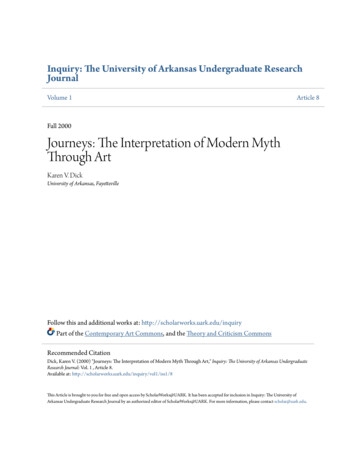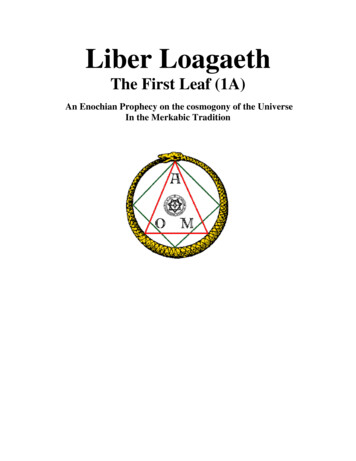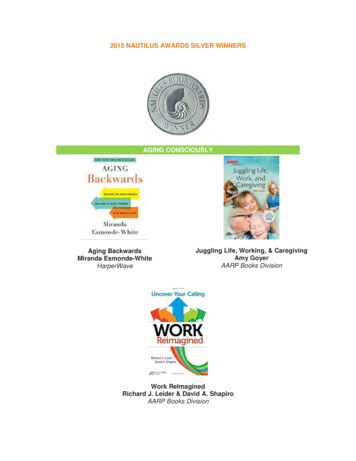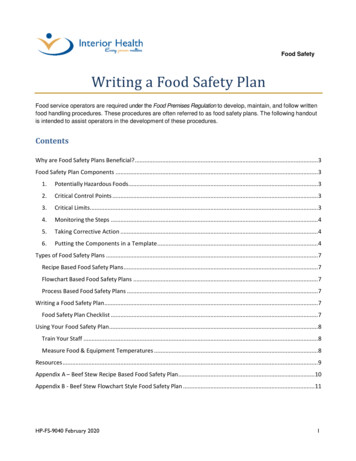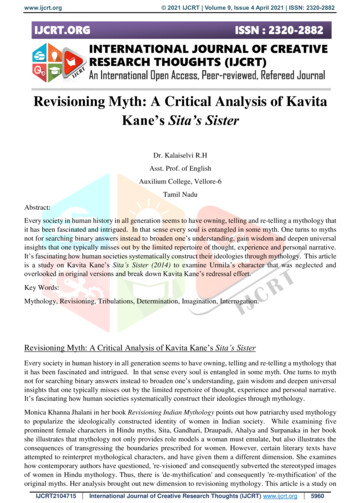
Transcription
www.ijcrt.org 2021 IJCRT Volume 9, Issue 4 April 2021 ISSN: 2320-2882Revisioning Myth: A Critical Analysis of KavitaKane’s Sita’s SisterDr. Kalaiselvi R.HAsst. Prof. of EnglishAuxilium College, Vellore-6Tamil NaduAbstract:Every society in human history in all generation seems to have owning, telling and re-telling a mythology thatit has been fascinated and intrigued. In that sense every soul is entangled in some myth. One turns to mythsnot for searching binary answers instead to broaden one’s understanding, gain wisdom and deepen universalinsights that one typically misses out by the limited repertoire of thought, experience and personal narrative.It’s fascinating how human societies systematically construct their ideologies through mythology. This articleis a study on Kavita Kane’s Sita’s Sister (2014) to examine Urmila’s character that was neglected andoverlooked in original versions and break down Kavita Kane’s redressal effort.Key Words:Mythology, Revisioning, Tribulations, Determination, Imagination, Interrogation.Revisioning Myth: A Critical Analysis of Kavita Kane’s Sita’s SisterEvery society in human history in all generation seems to have owning, telling and re-telling a mythology thatit has been fascinated and intrigued. In that sense every soul is entangled in some myth. One turns to mythnot for searching binary answers instead to broaden one’s understanding, gain wisdom and deepen universalinsights that one typically misses out by the limited repertoire of thought, experience and personal narrative.It’s fascinating how human societies systematically construct their ideologies through mythology.Monica Khanna Jhalani in her book Revisioning Indian Mythology points out how patriarchy used mythologyto popularize the ideologically constructed identity of women in Indian society. While examining fiveprominent female characters in Hindu myths, Sita, Gandhari, Draupadi, Ahalya and Surpanaka in her bookshe illustrates that mythology not only provides role models a woman must emulate, but also illustrates theconsequences of transgressing the boundaries prescribed for women. However, certain literary texts haveattempted to reinterpret mythological characters, and have given them a different dimension. She examineshow contemporary authors have questioned, 're-visioned' and consequently subverted the stereotyped imagesof women in Hindu mythology. Thus, there is 'de-mythification' and consequently 're-mythification' of theoriginal myths. Her analysis brought out new dimension to revisioning mythology. This article is a study onIJCRT2104715International Journal of Creative Research Thoughts (IJCRT) www.ijcrt.org5960
www.ijcrt.org 2021 IJCRT Volume 9, Issue 4 April 2021 ISSN: 2320-2882Kavita Kane’s Sita’s Sister (2014) to examine Urmila’s character that was neglected and overlooked inoriginal versions and break down Kavita Kane’s redressal effort.Urmila is Rama’s brother Lakshman's bride, whom he left behind in the palace of Ayodhya for fourteenlonely years. Instead pause and ponder Urmila could have insisted on joining her husband as Sita did. But shedid not. Instead, she silently held her tears, fought her tragedy and loneliness. Kavita Kane’s Urmila isvulnerable yet strong, beautiful and young woman with full of life and hope to live her normal life but becomea victim of someone’s action, her husband’s decision to accompany his brother to forest leaving his youngbride. Like Alicia Ostriker states in her essay Stealing the Language. “we cannot measure the work of womenpoets, past or present, without a thorough--and if possible demystified-- awareness of the critical context inwhich they have composed and continued to compose their work (3). Kavita Kane’s Sita’s Sister is one of theclassic examples of Feminist revisionist mythology. A revision mythmaking is a strategic revisionist use ofgender imagery and is a means of exploring and attempting to transform the self and the culture or, in otherwords, to “subvert and transform the life and literature women poets inherit”.Lisa Tuttle has defined feminist theory as asking new questions of old texts and she cites the goals of feministcriticism as “(1) developing and uncovering a female tradition of writing, (2) interpreting symbolism ofwomen's writing so that it will not be lost or ignored by the male point of view, (3) rediscovering old texts,(4) analysing women writers and their writings from a female perspective, (5) resisting sexism in literature,and (6) increasing awareness of the sexual politics of language and style” (186). Feminist revisionistmythology tends to fulfil at least one of these goals.The hallmark of the Indian mythology is its strong female characters who had created a niche for themselves,through their strong sense of individuality. These strong women despite flagging their individuality, had alsodisplayed immense courage and mind of their own. They trusted their sensibilities and were bestowed withsharp acumen. Revisioning their tales through contemporary lens only adds to their inherent beauty andundiscovered charisma of their character.Chitra Banerjee Divakaruni’s The Palace of Illusions and Pratibha Ray’s Yajnaseni - The Story of Draupadiare both retellings of the great epic Mahabarath, through Draupadi’s point of view. Ray projected Draupadias a devoted wife and Divakaruni let her heroine long for the love of two invincible men Karna and Krishna.Recent writers like Kavitha Kane, Saiswaroopa Iyer, Utkarsh Patel have wielded their pens to revision themyths in feminist lens.Authors have used several methods of revising the myths, retelling them from the point of female characters,thereby breaking down the treatment of women as docile and submissive characters, but transform them asindividuals of sustainability. Frances Babbage in her work In Revisioning Myth: Modern and ContemporaryDrama by Women says, “Myths and practices of rewriting can be means of revealing shared attitudes andexperience” (5). She explores the ideological and aesthetic potential of such practice and elucidates thetensions that are seen in the narratives that have fundamentally shaped the western thought. Kavitha Kane isconsidered as a revolutionary force in Indian writing, introducing a feminist perspective in Indian Mythology.To an interview to the Hindu, Kane has stressed the importance of mythology:If myths reflect the socio-cultural ethos of earlier times, they can also be used tocontemporaries those same issues in today’s world. Actually, nothing has changed. Love,rivalry, disappointment, war, anger, greed, all these emotions still exist. There’s a chance ofan alternative perspective by looking at the epics through the women and minor characters atthat. (The Hindu)Kane believes that mythology is a literary device to portray contemporary issues and sensibilities. She haswritten few books over the years that are dominantly feminist in nature. She recreates the stories byintroducing most unusual characters that have a little say in the original text. Kane’s Sita’s sister deals withUrmila, the little-known wife of Lakshman. Ramayana hadn’t given much significance to this character butIJCRT2104715International Journal of Creative Research Thoughts (IJCRT) www.ijcrt.org5961
www.ijcrt.org 2021 IJCRT Volume 9, Issue 4 April 2021 ISSN: 2320-2882Kane has embellished her as a titular character, as breathing heroine, who anchors the family of Rama undergreater troubles. Kane has thus subverted the stereotyped image of women in mythology.The sacrifice rendered by Lakshmana and Urmila in Ramayana is not much spoken of. When Lakshmanawanted to serve his brother and his wife in the forest during their exile, he ignored sleep and that was possibleas his wife Urmila embraced sleep for fourteen long years on behalf of him. Though a young wife, Urmilacould surrender herself to her husband’s utmost desire of service, by shunning all the pleasures of palace life.Kane has weaved a brilliant imagination of Urmila’s life in the fourteen years sculpting her as a matchlessheroine, as one who undergoes immitigable pain and anguish, just to render her service to her husbandLakshmana. She says, “Interpret the sleep as a metaphor for loneliness and loss” (The Hindu). WhenLakshman chooses to accompany his brother Ram to the forest, Urmila could have insisted joining him butshe does not. Kane reasons out Urmila’s much preferred duty to her husband and shapes her character as onewho possesses much wit, grit and vivacity.Janak’s four daughters Sita, Urmila, Mandavi and Shruta Kirti get married to the four sons of Ragukula clan,Ram, Lakshman, Bharath and Satrukan. The novel gears up after these young women move into their in-law’sfamily at Ayodhya. Everything seems to be rosy at the beginning but the misfortune befalls on them when MaKaikeyi gets the promise from King Dasarath, to make her son Bharath the King of Ayodhya. Further shedemands King Dasarath to send Ram into fourteen long years of exile to the forest.Urmila’s real struggle begins at this juncture. She is numb at this merciless demand which trifles her as abullet. Her brain stumbles at the sudden twist of events and gets shattered further when Lakshman decides toescort Ram and Sita to the forest. He says to Ram, “We have always been together; we are, as you said, onesoul in two bodies. So do not refuse me Ram, because I shall follow you nevertheless. You cannot stop me”(140). She is speechless as she watches the two people who she loved have taken the decision to leave her forfourteen years. She is torn with conflicting emotions and feels bereft and unwanted.She lashes Lakshman with hurtful words intentionally to hurt him, “You cannot stay back for me becauseyour brother is more precious than your wife. You are not like your father to listen to his wife, are you?”(147). She taunted. When Lakshman leaves with Ram and Sita, Urmila is satisfied with her behaviour, hurthim wilfully only to make him hurt her. She feels she has made it easier for him to hate her, rather than loveher for the next fourteen years of separation. It is here in this context Kane’s Urmila stands up. Urmila’s lovefor her husband is divine and selfless. When Ram feels sad for taking Lakshman with him she says, “It’s fora higher calling, a nobler mission, you are taking my husband. He will always be there for you” (154). Hernobility in accepting the duty and mission undertaken by her husband implicates her devotion towards herrole as a wife and daughter-in-law. At the time of their departure, Lakshman understands her intention ofhurting him and convinces her, “It’s the memory of our full, sustained love which will never make us feelalone or lonely” (157).In the palace, Urmila uses all her strategy to put cunning Manthara in her place. When she has an opportunityto deal with Manthara, she retorts, “I’m not in a habit of discussing my personal life with maids” (167).Manthara loses her ground as her deviousness is now exposed and this is the first victory in the palace forUrmila. She also assures Manthara that Bharath would never accept the crown and that he would throw herout and hate his mother forever for the ignoble act of hers.On his return Bharath understands his mother’s evil intension and screams, “She has harmed me, my name,my character, my reputation, my ideals” (192). But Urmila is shocked at his brutality and advices him not tospeak such harsh words to his mother as she’s not his enemy but his mother. She’s able to hide her pain andadvices her brother-in-law of the noble things he needs to embrace for the welfare of the Kingdom. WhenBharath leaves the palace of Ayodhya to meet Ram in the forest, Urmila refuses to go with him to persuadeLakshman to come back. Instead, she says with much resolve, “I am needed at the palace, I shall remain hereIJCRT2104715International Journal of Creative Research Thoughts (IJCRT) www.ijcrt.org5962
www.ijcrt.org 2021 IJCRT Volume 9, Issue 4 April 2021 ISSN: 2320-2882with Mandavi and Kirti” (208). But Sumithra convinces her to go with the troop to meet Ram and Lakshmanin the forest.In the forest Urmila asserts her husband that she is proud of him and wishes him whole heartedly to fulfil hisduty. At the same time, when Bharath also says that he would live like an ascetic, leaving his wife and thepalace, Urmila gets frustrated and shattered. She boldly confronts all the Gurus in the room, “Today in thisroom, we have talked about all sorts of Dharma – of the father and the sons, of the kings and princess, of theBrahmin and the Kshatriya – even of the wife for her husband. But is there no Dharma of the husband for hiswife? No Dharma of the son for his mother? Is it always about the father, sons and brothers?” (219). WhenGuru Kashyap tries to stop her vindication, she brings it out boldly the tradition in the royal family. She blurtsout, “This royal family is famous for its justness when it comes to its people and the state, but is cruellest toits own family members. Just is here is not blind – it is deaf and mute” (222). When the gathering is astonishedat her words, Lakshman gives her warmth through his smile assuring her. Urmila’s austerestraightforwardness surprises everyone.In the palace Urmila shows unmitigated courage and wisdom in dealing with the affairs of the Kingdom. Sheeven gathers everyone for lunch with the aim of recreating the past days of happiness. Her noble heart isshowcased when Mandavi despises Queen Kaikeyi of her evil move. Urmila says, “She is suffering, it is worsefor her – everyone despises her, avoids her; she has become an outcast in her own home” (233). Urmila’s gritto establish peace in the palace is evident in every single action she does. She asserts Queen Kousalya thatshe was taught to protest against injustice at Mithila and that she would never watch the injustice being doneto the women in the palace, because of the mistakes of the elders. Her feministic voice to revolt against theinjustice is evident in the ways she rises against the atrocity meted out by women.Finally, when she understands the real intention of Ma Kaikeyi in sending Ram to exile, she appreciates herwith mounting respect and admiration. Urmila’s duty as a daughter in law of the family shines in every anglepossible. She gracefully takes care of everyone, though herself being smitten by the pangs of separation. Shereaches the pinnacle of glory when her father Janak invites her to the philosophical conference, the prestigiousBrahman yagna – which he hosted every year. He requests her to attend the annual symposium in her ownright as an acclaimed scholar. At the conference, Urmila sits amongst the brilliant minds feeling a sense ofdeep humility and calmness. She feels she is Urmila, not just the woman of passion as her name so definedher, but one who’s heart and mind came together in intellectual and spiritual enrichment.Retelling the mythological stories helps to unveil the truths about human nature, more so with women.Women’s lives, their anticipations and principles, their contribution to the society and its reality and the idealsof womanhood are considerably shaped by the models of womanhood that are set out in the stories andlegends. In doing so, their natural vivacity and sustainability are clouded and their innate nature is not spokenaloud. Especially in the myths, the portrayal of women has been one-sided always, depicting them assubmissive individuals, standing atop as an epitome of sacrifice. Retelling myths with a contemporary lenshelp to hold the mirror up to nature, bringing out some of their darkest intimidations and passions and at thesame time, display their latent strength to the external world. Kane in embellishing Urmila’s character, hasbrought out the immense wisdom and courage of women, who in the midst of pressure and problems staystrong to anchor their families and themselves.IJCRT2104715International Journal of Creative Research Thoughts (IJCRT) www.ijcrt.org5963
www.ijcrt.org 2021 IJCRT Volume 9, Issue 4 April 2021 ISSN: 2320-2882Works Cited1.Kane, Kavita. “Through the Mythical Lens.” Interview by R. Krithika. The Hindu 5th March20202.Babbage. Frances. In Revisioning Myth: Modern and Contemporary Drama by women. NewYork: Manchester UP, 2011.3.Kane, Kavita. Sita’s Sister. New Delhi: Rupa Publications India Pvt. Limited, 2014.4.Tuttle, Lisa. Encyclopaedia of Feminism. Harlow: Longman 1986.5.Ostriker, Alicia, Stealing the Language: The Emergence of Women's Poetry in America.Women's Press, 1987. pp. 2–3.6.Jhalani, Monica Khanna. Re-visioning Mythology in Indian Literature. India: LAPLAMBERT Academic Publishing; 1st edition (1 January 2017)IJCRT2104715International Journal of Creative Research Thoughts (IJCRT) www.ijcrt.org5964
Revisioning Myth: A Critical Analysis of Kavita Kane's Sita's Sister Every society in human history in all generation seems to have owning, telling and re-telling a mythology that . undiscovered charisma of their character. Chitra Banerjee Divakaruni's The Palace of Illusions and Pratibha Ray's Yajnaseni .
